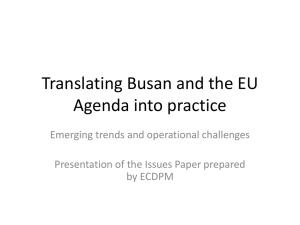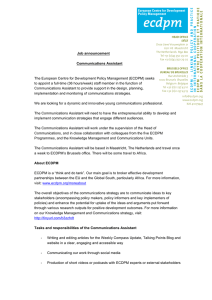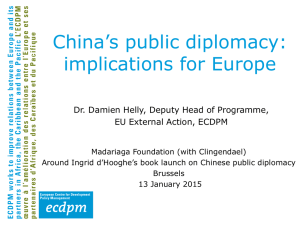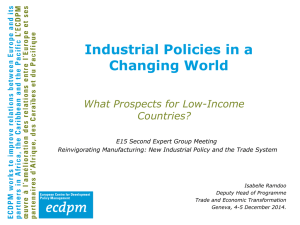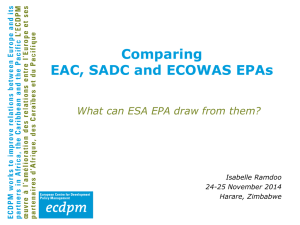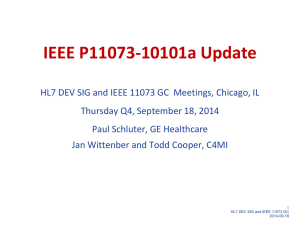the presentation
advertisement
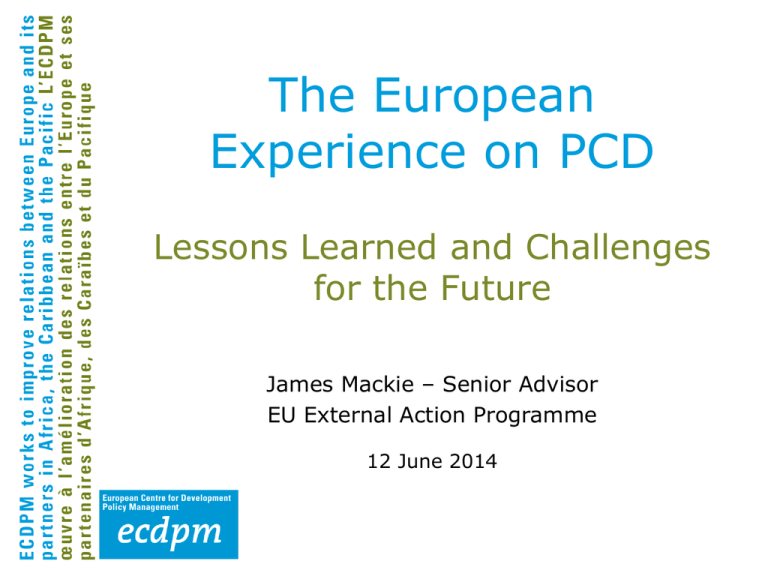
The European Experience on PCD Lessons Learned and Challenges for the Future James Mackie – Senior Advisor EU External Action Programme 12 June 2014 I. We have come a long way since Maastricht ECDPM Page 2 Overview –22 years of PCD in the EU Legal status: •Treaty of Maastricht (1992), Art. 130v. ‘The 3 Cs’ •Lisbon Treaty (2009), Art. 208. •Cotonou Agreement (2000), Art. 12 Political commitment: •European Consensus on Development (2005) - 12 priority areas. •FA Council (2009): “a more focused, operational and result-oriented approach to PCD” •FA Council (May 2012): “PCD is essential for the credibility of the EU as a global actor” •FA Council (Dec 2013) “need for regular political PCD discussions” Policy: •Agenda for Change (2011): security and migration + “future MFF should reinforce PCD” •COM (2009) … : 12 > 5 priority areas (T&F, CC, FS, MG, SEC.) •PCD Work Program (2010-2013) Post-2015: “A decent life for All” + Council Conclusions ECDPM Page 3 Three periods • 1990s – slow on the uptake • Little discussion – MS reluctance to move on 3Cs • Definitional issues – what do we mean by coherence? • NGO lobbying on coherence – kept up pressure • 2000s – picked up steam • • • • European Consensus on Development Member States efforts made 3Cs Evaluations – mechanisms being put in place Biennial EU PCD reports – monitoring • 2010s – consolidation and now some soul searching • Repeated declarations and monitoring, but … • How to sustain the effort … and now … where next? ECDPM Page 4 Legal basis In the EU Treaty: •Treaty of Maastricht 1992: “The Community shall take account of the objectives [of development cooperation] in the policies that it implements which are likely to affect developing countries” (Art. 130v). •Treaty of Lisbon 2009 extends this to the whole Union: “The Union shall take account of the objectives of development cooperation in the policies that it implements which are likely to affect developing countries” (Art. 188D). And externally a commitment to development partners: •Cotonou Agreement 2000: “…where the Community intends, … , to take a measure which might affect the interests of the ACP States, as far as this Agreement’s objectives are concerned, it shall inform … the said States of its intentions”. (Art 12) ECDPM Page 5 Political Commitments • 2005 EU Consensus on Development • • • Introduced name “Policy Coherence for Development” (PCD) Monitor progress in 12 policy areas through biennial reporting. 2009 Review of PCD approach • • • Agreement to engage proactively in 5 areas instead of 12 priorities Council Conclusions acknowledge progress on PCD in EU MS (official commitments/ institutional capacity); yet call for “a more focused, operational and result-oriented approach” Agreement to develop PCD Work Programme • 2010 First Report on PCD by EU Parliament • 2011 Agenda for Change – reconfirms EU action to improve PCD • Most recent: PCD as part of the post-2015 agenda • • • • ECDPM A Decent Life for All, COM(2013)92 Council Conclusions (June 2013) on post-2015 position & PCD report EU PCD Report 2013 A Decent Life for All: from vision to action COM(2014)335 Page 6 Progress on PCD mechanisms 25 20 15 10 5 0 1992 1993 1994 1995 1996 1997 1998 1999 # EU MSs and institutions which made PCD policy statements 2000 2001 2002 2003 2004 2005 2006 # EU MSs and institutions who put in place PCD mechanisms Source: Mackie et al., 2007, 3Cs Study No.7, Aksant, p.49, http://www.three-cs.net ECDPM Page 7 Mechanisms to promote PCD – 3Cs Evaluations Different types: i. Policy statements ii. Institutional & administrative mechanisms iii. Knowledge & assessment capacity Really need all three Each serves a purpose → a PCD System ECDPM Political NSA Context Pressures i. Policy statements of intent ii. Institutional & ii.administrative Institutional & administrative mechanisms b. Resolve a. Strengthen mechanisms to: incoherencies coherence to: iii. Knowledge inputs & assessment capacity Approach to Knowledge governance communities Page 8 PCD mechanisms – case studies Common approaches: • France – Inter-ministerial committee • Netherlands – PCD Unit in MFA • Finland – Development policy committee • EC – Inter-service consultation system • EP – role of Development Committee • Council – working groups Most sophisticated approach: • Sweden – Global development policy Lessons with hindsight • Raising awareness – recognising ‘PCD mechanisms’ • Same types of mechanisms are still in use 10 years later ECDPM Page 9 PCD mechanisms at the EU level Institutional Knowledge & Assessment •DEVCO A1 – PCD Unit •Stakeholder consultations •Inter-service consultations •Impact Assessment process •PCD Inter-service group •Dialogue processes (eg. Cotonou Agreement / Delegations) •PCD Network •Council: CODEV, COREPER presidencies •EU Parliament: Standing Rapporteur for PCD • Bi-annual report on PCD at EU and MS + Commission PCD … 2007, 2009, 2011, 2013 • Piloting Impact Assessments at country level (Food Security) DAC Peer Review 2012: “While appropriate institutional mechanisms (…) have been developed, these instruments are not yet used to their full potential” ECDPM Page 10 Strengthening the evidence base of PCD for OECD Members Pilot Methodology for country-level impact assessments of PCD on food security •Identifies and Assesses the impacts of OECD policies on food security in individual developing countries. •Flexible tool including a) Framework for analyzing international policy linkages and domestic policy context b) Sequence of research modules tailored to objectives and capacity in developing countries c) Integration of local consultation processes and stakeholder views – a tool to enhance dialogue •Currently tested in first pilot Countries (e.g. Tanzania) Supported by Finland and Switzerland ECDPM Page 11 Good progress on mechanisms - yet how much has really changed? European Report on Development (2013): “The EU has made more efforts on PCD than most, but the impact of these efforts remains limited” • Operational PCD-commitments are made only by DEVCO, while other DGs, European Council and European Parliament are only bound by broad treaty obligations; • Inadequate resources do not match policy statements; • Alignment with PCD Work Program 2010-2013 remains voluntary and depends on political priorities of the MS; • Development is never first priority when it comes to trade-offs > Decreasing ODA figures ECDPM Page 12 Walking the talk: policy vs. practice • CAP: Commission, European Parliament and Council refuse to monitor external impact while maintaining export subsidies. • Illicit Financial Flows: tax loopholes remain and money laundering still to be criminalised despite commitments. • Trade (Economic Partnership Agreements with developing countries): the elephant in the room – good for development or not? “It’s the politics and competing interests, stupid!” ECDPM Page 13 II. Lessons learned? Opportunities and Challenges for PCD in post-2015 ECDPM Page 14 1. Opportunities for PCD Post-2015 Post-2015 debate can bring renewed impetus and opportunities for PCD •PCD required to achieve ambitious post-2015 goals (ERD 2013: ‘Beyond Aid’ – PCD vital tool). •Financing & Other Means of Implementation debate • PCD helps creating conducive environments for post2015 financing to be more effective (ERD 2014) •Sustainable development agenda needs more crosscutting integrated approaches (e.g. various DGs/ministries working together) ECDPM Page 15 2. Bottlenecks for PCD in the EU & even more so at global level for post-2015 Little public attention Underdeveloped structures for knowledge-input Lack of research on impact of (in)coherencies Many policies … Higher risk of incoherent policies ECDPM Monitoring, analysis and reporting Lack of political pressure Setting and prioritising objectives Coordinating policy and its implementation Difficult conversations between generalists vs. specialists • • • Few resources allocated Diverging interests Knowledge gaps Differing levels of awareness Page 16 3. How to sustain leadership? • PCD is a long-term issue and requires clear political leadership: • How does one sustain political support for PCD over lives of successive governments? • How do you create the incentives to push for PCD? • At global level MDG 8 alone was not sufficient to sustain long-term commitment • Dilemma of balancing values and interests • Principle of smart sovereignty • What PCD promotion strategy can we find at the global level for the post-2015, that • Evolves over time? • Promotes political commitment? ECDPM Page 17 4. A Universal PCD agenda? • How to overcome the donor-recipient paradigm inherent in the current PCD? • Policy Coherence is a problem of all government • ‘Joined-up government’ is a challenge everyone faces • Yet so far posed as a challenge for donor governments • PCD so far had clear beneficiaries • Can we find a universal PCD agenda in the post-2015 framework without loosing the clarity of the concept? • Need to assign clear responsibilities for PCD and ‘beyond aid’ in MoI and goals discussions • Yet, inherent tension between overcoming old paradigms and assigning responsibilities for PCD ECDPM Page 18 5. PCD as global policy tool? • There is no one-size fits all approach • PCD systems and how they manifest themselves operationally varies widely, dependent on • Political culture • Nature of administration systems • How can PCD tools best be • Promoted in the post-2015 context? • Adapted to different circumstances so they are relevant to varying contexts? ECDPM Page 19 6. Knowledge Inputs • Monitoring – essential for pushing political awareness • PCD Reports - are a vital tool though seem bland • • • • Document step by step progress throughout EU Focus largely on success stories / good practice Much harder to document difficulties Provoke debate – probably their most important role • Measuring impact of PCD • Problem of attribution • Evidence of incoherence much clearer than for coherence • But trying to make progress on this front • To support PCD in the universal post-2015 context • Data and knowledge challenges huge ECDPM Page 20 6. Dialogue – PCD Accountability Gaps? • In EU so far only few examples of clear mechanisms to exchange knowledge on PCD between countries? • Multilateral platforms, such as Cotonou Partnership Agreement Art.12, rarely used • ACP-EU Joint Parliamentary Assembly could be a tool • Impact assessments and PCD knowledge-based policymaking remains weak • Knowledge inputs rarely shared between governments • How to foster more Dialogue on policies and PCD in the post-2015 context • With partner countries? • At the multilateral level? ECDPM Page 21 III. Where has the road since Maastricht taken us? ECDPM Page 22 Conclusions • Have made real progress over 22 years • May be slow, but task is also extremely difficult • Awareness levels now much higher • PCD is clearly on the agenda • We know what mechanisms to use and how they work • Consultation systems in place • Have the monitoring tools • Impact assessments becoming stronger • Different actors in the PCD System play their roles • Council, EC, EP, Member States, NGOs, researchers … • Looking closer into measuring PCD • Key challenges remaining • Maintaining political leadership over time • Converting PCD into a universal agenda at global level • Improving knowledge inputs ECDPM Page 23 Thank you www.ecdpm.org www.slideshare.net/ecdpm James Mackie, jm@ecdpm.org Anna Knoll, ak@ecdpm.org Page 24

